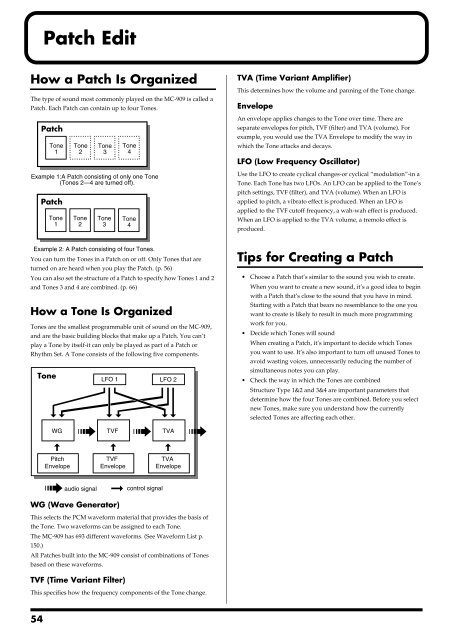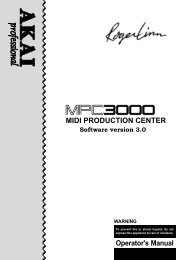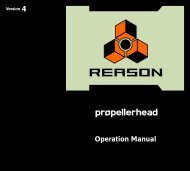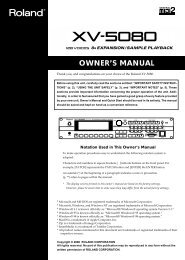MC909 Manual - SampleKings
MC909 Manual - SampleKings
MC909 Manual - SampleKings
- No tags were found...
Create successful ePaper yourself
Turn your PDF publications into a flip-book with our unique Google optimized e-Paper software.
Patch EditHow a Patch Is OrganizedThe type of sound most commonly played on the MC-909 is called aPatch. Each Patch can contain up to four Tones.fig.2-01.eTone1Example 1:A Patch consisting of only one Tone(Tones 2—4 are turned off).Tone1Tone2Tone2Tone3Tone3Tone4Tone4TVA (Time Variant Amplifier)This determines how the volume and panning of the Tone change.EnvelopeAn envelope applies changes to the Tone over time. There areseparate envelopes for pitch, TVF (filter) and TVA (volume). Forexample, you would use the TVA Envelope to modify the way inwhich the Tone attacks and decays.LFO (Low Frequency Oscillator)Use the LFO to create cyclical changes-or cyclical “modulation”-in aTone. Each Tone has two LFOs. An LFO can be applied to the Tone’spitch settings, TVF (filter), and TVA (volume). When an LFO isapplied to pitch, a vibrato effect is produced. When an LFO isapplied to the TVF cutoff frequency, a wah-wah effect is produced.When an LFO is applied to the TVA volume, a tremolo effect isproduced.Example 2: A Patch consisting of four Tones.You can turn the Tones in a Patch on or off. Only Tones that areturned on are heard when you play the Patch. (p. 56)You can also set the structure of a Patch to specify how Tones 1 and 2and Tones 3 and 4 are combined. (p. 66)How a Tone Is OrganizedTones are the smallest programmable unit of sound on the MC-909,and are the basic building blocks that make up a Patch. You can’tplay a Tone by itself-it can only be played as part of a Patch orRhythm Set. A Tone consists of the following five components.fig.2-02.eToneLFO 1 LFO 2Tips for Creating a Patch• Choose a Patch that’s similar to the sound you wish to create.When you want to create a new sound, it’s a good idea to beginwith a Patch that’s close to the sound that you have in mind.Starting with a Patch that bears no resemblance to the one youwant to create is likely to result in much more programmingwork for you.• Decide which Tones will soundWhen creating a Patch, it’s important to decide which Tonesyou want to use. It’s also important to turn off unused Tones toavoid wasting voices, unnecessarily reducing the number ofsimultaneous notes you can play.• Check the way in which the Tones are combinedStructure Type 1&2 and 3&4 are important parameters thatdetermine how the four Tones are combined. Before you selectnew Tones, make sure you understand how the currentlyselected Tones are affecting each other.WGTVFTVAPitchEnvelopeTVFEnvelopeTVAEnvelopeaudio signalcontrol signalWG (Wave Generator)This selects the PCM waveform material that provides the basis ofthe Tone. Two waveforms can be assigned to each Tone.The MC-909 has 693 different waveforms. (See Waveform List p.150.)All Patches built into the MC-909 consist of combinations of Tonesbased on these waveforms.TVF (Time Variant Filter)This specifies how the frequency components of the Tone change.54







